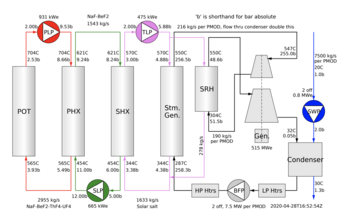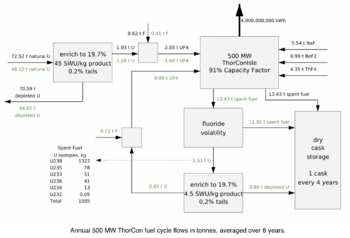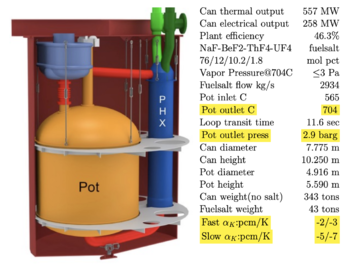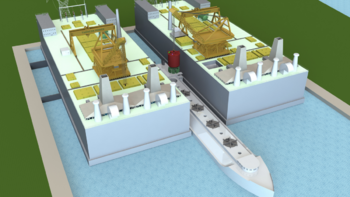ThorCon nuclear reactor

ThorCon power train. An extra heat exchange loop ensures no leakage of radiation. Overall efficiency is still above 46%.[2]

Raw material flows and waste at a ThorCon fuel processing plant. Enriched uranium powers the cycle, but most of the energy comes from the more abundant thorium.[3]
ThorCon nuclear reactors are molten salt reactors with a graphite moderator. These reactors (and the entire power plant) are to be manufactured on an assembly line in a shipyard, and delivered via barge to any ocean or major waterway shoreline. The reactors will be delivered as a sealed unit and never opened on site. All reactor maintenance and fuel processing will be done at a secure location.
This article provides ThorCon's answers to the questions raised in Nuclear power reconsidered. To read what people are saying around the web about these questions, see the Debate Guide tab for this article.
For more details about this reactor, see the ThorCon documents [4] and ThorCon's Status Report to the IAEA.[5]
Safety
Accidental overheating. Molten salt reactors have an inherent safety feature, a negative temperature coefficient of reactivity. As the salt gets hot, it expands, and the fission reactions slow down.[6] In any casualty that raises the temperature much above operating level, there are plugs at the bottom of the reactor vessel that will melt, allowing the fuel to flow out of the reactor into drain tanks, where the fission reaction stops, and the decay heat is absorbed by a "cold wall".[7] Safe shutdown does not depend on any mechanical, electrical, or computer systems.[8] No operator action is required, and there is nothing an operator can do to stop a safe shutdown. Proponents of nuclear call this "walk-away safe".
Leakage of Radioactivity The molten salt circulates at low pressure, and any leakage from the reactor will quickly solidify. The most troublesome fission products, including iodine-131, strontium-90, and cesium-137, are chemically bound to the salt. There is no pressurized water near the reactor vessel. Leakage to the environment is blocked by three gas-tight barriers - the Can, the Silo, and the Hull.[9] Tritium is captured by getters in inert gas in the power module hall and in the secondary heat exchanger cell. A third salt loop allows any tritium penetrating both heat exchangers to be captured in the third loop.[8] Xenon and krypton bubble out in the header tank, are held in storage tanks until they have decayed to harmless levels, and are then cooled, compressed and stored.[10]
Sabotage The hull is a 10ft thick wall of sand with an inch of steel on each side, capable of blocking a jumbo jet with eight-ton engines.[8] Reactivity can be increased only by adding fuel slowly through an orifice inside the silo, out of reach of any rogue operator. The maximum rate of increase in reactivity is enough for load following, but never enough that the reactor can go prompt critical.[8] Should a group of terrorists seize control of the plant and attempt to remove fuelsalt, they would require use of the 500-ton deck crane, which could be easily disabled with small artillery.[11] There is no vulnerability to cyber attack for any safety-critical system.
Waste Management
The "waste" in the ThorCon fuel cycle is actually valuable fuel for future reactors.[12] Like other moderated reactors, a once-through fuel cycle uses less than one percent of the available energy in the mined uranium. Spent fuel salt is an easily stored solid. ThorCon power plants can store up to 80 years of used fuel onboard, using passive air cooling.[13]
Average per year for a 500 MW plant running at 91% capacity:[3]
High Level Waste: 13,400 kg to dry-cask storage (81 grams per MegaWatt-day).
Medium and Low Level Waste: 172 tonnes of irradiated steel (one of the 4 "cans" every two years) shipped out for refurbishment.
Recycled Fuel: 650 kg of 19.7% U-235 (33% of total U consumption)
Other: (Medical isotopes, etc.)
Weapons Proliferation
ThorCon has a paper on Safeguards and Security [14] with a thorough discussion of the threats and countermeasures. Here is a short summary:
Reactors are delivered as sealed cans and never opened on site. All reactor maintenance and fuel processing is done at a central secure location.
The sealed cans are inside a high-radiation silo under a heavy concrete lid. Any attempt to get inside the silo can be detected by sensors and security cameras and stopped by local police or military.
There is no online chemical processing to remove fission products or anything else, and no highly enriched material anywhere — none above 20% U-235.
Uranium is low-enriched for the entire fuel cycle. Making bombs from this material will require a full-scale enrichment plant, no different than starting from readily available uranium ore.
Plutonium is absent from the initial fuel load, but it does build up as the fuel is consumed. By the time there is any amount useful for bomb making, it is in fuel salt loaded with hazardous fission products and thorium. Separating plutonium from thorium is so difficult that it has never been implemented on an industrial scale.[15]
If ever a situation develops with worry about plutonium separation, ThorCon plans to "spike" the initial fuel load with a small amount of spent fuel containing Pu-238, Pu-240, and Pu-242.[16] These isotopes, with their high rate of spontaneous fission, will cause a bomb to fizzle, not detonate.[17] Enrichment to weapons grade Pu-239 from isotopes that are heavier and lighter by only 0.4% will be much more difficult than current enrichment methods (separating U-235 from U-238, 1.3% mass difference).
ThorCon is not a breeder reactor. It requires a continuous input of fresh fuel, or the reaction stops. Any attempt to divert fissile material can be detected by comparing numerous hourly logs, including the fuel input and the power output. Spent fuel is left in its original sealed can, and never opened on site.
For more on how nuclear power plant fuel can be made useless for bombs, see chapter 14, Isotopic Uranium and Plutonium Denaturing as an Effective Method for Nuclear Fuel Proliferation Protection [18] in the book Nuclear Power - Deployment, Operation and Sustainability.[19]
Cost
ThorCon claims the expected cost of a complete power plant will be less than a coal plant of equal power.[20] Everything except the structure itself is replaceable. After four years of operation and four years of cooling, the sealed reactor can with the entire primary loop is returned to a centralized recycling facility, decontaminated, disassembled, inspected, and refurbished. Incipient problems are caught before they can turn into casualties. ThorCon plants with replaceable sealed reactors are expected to operate for 80 years; but if a ThorCon is decommissioned, the process is little more than pulling out but not replacing all the replaceable parts.[21]
Specs for a 500 MW plant:[8]
Plant cost per kW: $1200
Operating cost per kWh: $0.03 (including $0.006 for fuel)
Fuel consumption per day: 5.3 kg of 19.7% enriched uranium plus 9.0 kg of thorium.[3]
" " per MegaWatt-day: 11.6 grams U per MWd plus 19.7 grams Th per MWd.
-145 tonnes of natural uranium per GW-year compared to about 250 tonnes for a standard light water reactor
- future re-enrichment of spent fuel will cut this uranium requirement by a third
Initial fuel load (2 cans): 78,000 kg NaF-BeF2-ThF4-UF4 (76-12-10.2-1.8 mol %)
The main challenge in designing a low-cost molten salt reactor is the lifetime of components exposed to high temperature and high levels of neutron irradiation. Expensive steels were used in early reactor experiments [22] to resist corrosion by the flowing molten salt. ThorCon uses standard steels.[23] Components with thin steel, like the heat exchangers, can be replaced. The reactor vessel and anything with thicker steel can be reused. At end-of-life, the slightly radioactive steel can be melted down and recycled for new reactors.
Lifetime of the reactor is actually limited more by the graphite moderator than by degradation of the steel. ThorCon’s graphite needs are similar to those of an HTGR (High Temperature Gas-cooled Reactor). Life expectancy is 4 years at 680C and total irradiation 3e22 n/cm2 by high-energy neutrons.[24] The steel and graphite for the reactors add a little more than 50 million dollars to the cost of a 500 MW plant.[23]
Design Notes
- For a complete presentation of this design, see the ThorCon documents.[4]
New reactor designs have been evolving for decades, and may continue for many more. ThorCon chose a design using existing well-tested technology that could be rapidly deployed while other companies perfected their more sophisticated designs. They chose a simple upscale of the MSRE [25], a Molten Salt Reactor that had been tested at Oak Ridge National Laboratory in the 1960's. In choosing this simpler design, ThorCon avoided many problems of more advanced designs, including the need for expensive materials to ensure long lifetime, worries about diversion of fissile material, and unexpected costs that might come up with less proven newer technologies.
ThorCons are designed to solve the immediate CO2 emissions crisis, but there are better solutions for centuries down the road. Fuel efficiency is better than existing PWRs (Pressurized Water Reactors), but still far short of what can be achieved in an FNR (Fast Neutron Reactor). ThorCons are not breeder reactors, making more fissile material than they consume, so they require an ongoing supply of enriched uranium. ThorCons require "high assay" enriched uranium. Heavy-water reactors can run on natural uranium.[26] ThorCons, like all moderated reactors, produce a waste stream with long-lived actinides. FNRs can burn anything - spent fuel including the actinides, old bomb cores, thorium, even depleted uranium.[27] ThorCon's temperature is much higher than existing PWRs and high enough for some process heat applications, but if we want to stop burning fossil fuels entirely, even higher temperatures [28] could provide "green hydrogen"[29] for a truly carbon-free economy.
Notes and References
- ↑ Fig.10 from Section 1.2 in ThorConIsle
- ↑ ThorCon Power Conversion.
- ↑ 3.0 3.1 3.2 ThorCon Fuel Cycle
- ↑ 4.0 4.1 ThorCon Isle
- ↑ IAEA Advanced Reactors Information System (ARIS) ThorCon_2020.pdf 2020/06/22.
- ↑ The neutron multiplication ratio in a fission reactor must be exactly 1.000 for steady-state operation. A small drop in reactivity will cause a rapid exponential decrease of the primary fission reaction rate. ThorConPower.com/Safety Negative TempCo
- ↑ The wall is kept "cold" by water that is replenished from a storage tank above the reactor. Circulation is maintained without pumps, because the hot water (or steam) rises in the space around the cold wall.
- ↑ 8.0 8.1 8.2 8.3 8.4 ThorCon SpecSheet7
- ↑ See section Release resistance in ThorCon Safety
- ↑ ThorCon Drain tank
- ↑ Section 6.2 in ARIS Status Report
- ↑ ThorCon’s spent fuel salt contains uranium 8.6% enriched in U235 and U233. ThorconPower.com/fuel
- ↑ ThorCon will send one cask to storage every four years. Each 3 m diameter cask results from 2 GW-years of electric power generation. At 5 m spacing 800 GW-years of casks would occupy one hectare. ThorconPower.com/fuel
- ↑ ThorCon's paper Safeguards and Security has a good review of the three threats posed by fissile material in a nuclear plant and measures needed to ensure proliferation resistance and fuel protection.
- ↑ See section 3.2.2 The Separation Problem in ThorCon's paper Safeguards and Security.
- ↑ For more on safeguards against plutonium diversion, see section 3.3 Spiking the Fuel: a Future Anti-proliferation Upgrade in ThorCon's paper Safeguards and Security.
- ↑ There is debate over whether "spiking" the fuel would prevent a detonation. Even a "fizzle" yield of a few kilotons could be a disaster in the hands of terrorists. See Blocking_Diversion_of_Plutonium_by_"Spiking"_the_Fuel.
- ↑ Kryuchkov et.al. (2011) Isotopic Uranium and Plutonium Denaturing as an Effective Method for Nuclear Fuel Proliferation Protection https://www.doi.org/10.5772/17822 Chapter 14 in Tsvetkov (2011), Nuclear Power - Deployment, Operation and Sustainability.
- ↑ Tsvetkov, P. (Ed.). (2011). Nuclear Power - Deployment, Operation and Sustainability. InTech. doi: 10.5772/704.
- ↑ See ThorCon Economics for a detailed analysis of cost, and ThorCon Production for a proposal to use shipyards for efficient production.
- ↑ "ThorCon is Fixable" p.1 in ThorConIsle
- ↑ The Molten Salt Reactor Experiment used an expensive alloy Hastelloy-N.
- ↑ 23.0 23.1 ThorConIsle 2019-03-03 p.26
- ↑ ThorCon graphite specification 2019-04-19
- ↑ See ThorConPower.com/history for a brief history of what many believe would have been a safer and more economical choice for commercial nuclear power.
- ↑ https://en.wikipedia.org/wiki/Pressurized_heavy-water_reactor
- ↑ FNR breeders like the FC-MSR Nuclear Reactor do require an initial load of enriched fissile material to "light the fire" before breeding can begin.
- ↑ High Temperature Gas-cooled Reactors like China's HTGR may provide the kind of heat needed for production of zero-carbon hydrogen from water.
- ↑ The Sulfur-Iodine Process S-I Diagram requires temperatures near 1000C to run efficiently.

